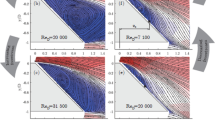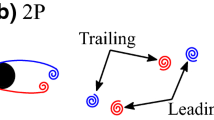Abstract
Recently there has been a new surge of interest in three-dimensional wake patterns, from both an experimental and analytical standpoint. One of the central discoveries is that the patterns of vortex shedding are dependent on the specific end conditions of a long cylinder span. However, a number of outstanding questions have remained unanswered, in part because techniques had not existed to control such patterns in a continuous fashion and from outside a test facility. In the present work, we have devised a method to control the end conditions of a cylinder span by non-mechanical and continuously-variable means, namely by the use of end suction. The technique allows a continuous variation of end conditions and admits transient or impulsive control. With the method, the classical steady-state patterns, such as parallel or oblique shedding or the ‘chevron’ patterns are simply induced. These experiments demonstrate that the wake, at a given Reynolds number, is receptive to a continuous (but limited) range of oblique shedding angles (θ), rather than to discrete angles. There is excellent agreement in these results with the ‘cos θ’ formula for collapsing oblique-shedding frequencies onto a single ‘universal’ frequency curve. The use of suction has avoided the grossly unsteady motions at the ends of the cylinder span brought about by the wakes of mechanical end manipulators, and we show that the laminar shedding regime exists up to Reynolds numbers (Re) of 205. The surprisingly large disparity among reported measurements of criticalRe for wake transition (Re=140−200), over the last forty years, can now be explained in terms of spanwise end contamination.
The control technique has also allowed experiments to be performed, which have resulted in the discovery of new phenomena such as ‘phase shocks’ and ‘phase expansions’. A major difference between these phenomena is that phase shocks (involving regions of straight vortices) translate spanwise at constant speed, crossing the complete span in a finite time, whereas a phase expansion (involving curved vortices) requires an infinite time to complete its development across the span. These transient wake patterns are well illustrated using a simple model, based on experimental measurements, that thenormal wavelength for oblique or parallel vortices remains constant. However, a detailed and close comparison between our experimental results and those results from analytical modelling of the wake using Ginzburg-Landau modelling (in collaboration with Peter Monkewitz at Lausanne) is presently underway. These equations yield a Burger's equation for the spanwise wavenumber (or phase gradient), from which both (phase) shocks and expansions are well-known solutions.
Sommario
Recentemente è rinato l'interesse per i modelli tridimensionali di scie, sia da un punto di vista sperimentale che da uno analitico. Una delle scoperte centrali è che le modalità di produzione dei vortici sono dipendenti dalle condizioni agli estremi di un lungo cilindro. Nel presente lavoro, è stato formulato un metodo per controllare le condizioni finali agli estremi di un cilindro per mezzo di variabili continue di significato non-meccanico, cioè per mezzo dell'aspirazione agli estremi. La tecnica permette una variazione continua delle condizioni agli estremi ed ammette controllo transitorio od impulsivo. Con questo metodo sono semplicemente indotti i classici modelli a stato fissato, come anche quelli che prevedono produzioni di vortici parallele od oblique o quellichevron. Questi esperimenti dimostrano che la scia, ad un dato numero di Reynolds, ammette una distribuzione continua (ma limitata) di angoli per distribuzioni oblique, piuttosto che una discreta. In questi risultati c'è un eccellente accordo con la formula del coseno per frequenze di produzioni oblique e collassanti su di una curva di frequenzauniversale. L'uso dell'aspirazione ha evitato i moti largamente instabili alle estremità del cilindro, provocati dalle scie delle parti terminali dei manipolatori, e si osserva che il regime laminare diffondente esiste oltre un numero di Reynolds pari a 205. La sorprendentemente larga disparità tra le misure di numeri di Reynolds critici, riportati per transizioni di scia (Re=140÷200) durante gli ultimi quattro anni, può essere ora spiegata in termini di contaminazione della estensione della lunghezza del cilindro.
Similar content being viewed by others
References
Albarede, P. and Monkewitz, P., ‘A model for the formation of oblique shedding patterns and ‘chevrons’ in cylinder wakes’,Phys. Fluids A4 (1992) 744–756.
Albarede, P., Provansal, M and Boyer, L., ‘Modelisation par l'équation de Guinzburg-Landau du sillage tri-dimensionel d'un obstacle allongé’,Compt. Rend. Acad. Sci. Paris,310 (1990) Serie II, 459.
Noack, B.N., Ohle, F. and Eckelmann, H., ‘On cell formation in vortex streets’,J. Fluid Mech. 227 (1991) 293.
Park, D.S. and Redekopp, L.G., ‘A model for pattern selection in wake flows’,Phys. Fluids,A4 (1992) 1697.
Triantafyllou, G.S., ‘Three-dimensional flow patterns in two-dimensional wakes’,J. Fluids Engin. trans. ASME,114 (1992) 356.
Monkewitz, P.A., Williamson, C.H.K. and Miller, G.D., ‘Three-dimensional phase dynamics in a cylinder wake’,Bull. American Physical Society 38 (1993).
Monkewitz, P.A., Williamson, C.H.K. and Miller, G.D., ‘Three-dimensional phase dynamics in a wake’, Submitted toPhys. Rev. Lett. (1994).
Roshko, A., ‘On the development of turbulent wakes from vortex streets’,NACA Report 1191 (1954).
Tritton, D.J., ‘Experiments on the flow past a circular cylinder at low Reynolds numbers’,J. Fluid Mech. 6 (1959) 547.
Williamson, C.H.K., ‘Defining a universal and continuous Strouhal-Reynolds number relationship for the laminar vortex shedding of a circular cylinder’,Phys. Fluids,31 (1988) 2742.
Eisenlohr, H. and Eckelmann, H., ‘Vortex splitting and its consequences in the vortex street wake of cylinders at low Reynolds number’,Phys. Fluids,A1 (1989) 189.
Koenig, M., Eisenlohr, H. and Eckelmann, H., ‘The fine structure in theS-Re relationship of the laminar wake of a circular cylinder’,Phys. Fluids,A2 (1991) 1607.
Hammache, M. and Gharib, M., ‘A novel method to promote parallel shedding in the wake of circular cylinders’,Phys. Fluids,A1 (1989) 1611.
Hammache, M. and Gharib, M., ‘An experimental study of the parallel and oblique vortex shedding from circular cylinders’,J. Fluid Mech. 232 (1991) 567.
Williamson, C.H.K., ‘Oblique and parallel modes of vortex shedding in the wake of a circular cylinder at low Reynolds numbers’,J. Fluid Mech. 206 (1989) 579.
Koenig, M., Noack, B.R. and Ecklemann, H., ‘Discrete shedding modes in the von Karman vortex street’, Submitted toPhys. Fluids (1993).
Leweke, T. and Provansal, M., ‘Wake of a torus’,Compt. Rend. Acad. Sci. Paris,227 (1993) Serie II, 293.
Corke, T., Koga, D., Drubka, R. and Nagib, H., ‘A new technique for introducing controlled sheets of streaklines in wind tunnels’,IEEE Publication 77-CH 1251-8 AES (1977).
Strykowski, P., Private Communication (1991).
Williamson, C.H.K., ‘Three-dimensional vortex dynamics in nominally two-dimensional wakes’, chapter in Green, S.I. (Ed.),Fluid Vortices (to be published by Kluwer Academic Publishing, Amsterdam, The Netherlands, 1994).
Williamson, C.H.K., ‘The natural and forced formation of spot-like “vortex dislocations” in the transition of a wake’,J. Fluid Mech. 243 (1992) 393.
Bloor, M.S., ‘The transiton to turbulence in the wake of a circular cylinder’,J. Fluid Mech. 19 (1964) 290.
Norberg, C., ‘An experimental investigation of the flow around a circular cylinder: influence of aspect ratio’,J. Fluid Mech. 258 (1994) 287.
Williamson, C.H.K., ‘The existence of two stages in the transition to three-dimensionality of a cylinder wake’,Phys. Fluids 31 (1988) 3165.
Provansal, M., Mathis, C. and Boyer, L., ‘Benard-von Karman instability: transient and forced regimes’,J. Fluid Mech. 182 (1984) 1.
Author information
Authors and Affiliations
Rights and permissions
About this article
Cite this article
Williamson, C.H.K., Miller, G.D. Three-dimensional phase dynamics in a cylinder wake. Meccanica 29, 411–429 (1994). https://doi.org/10.1007/BF00987576
Received:
Accepted:
Issue Date:
DOI: https://doi.org/10.1007/BF00987576




